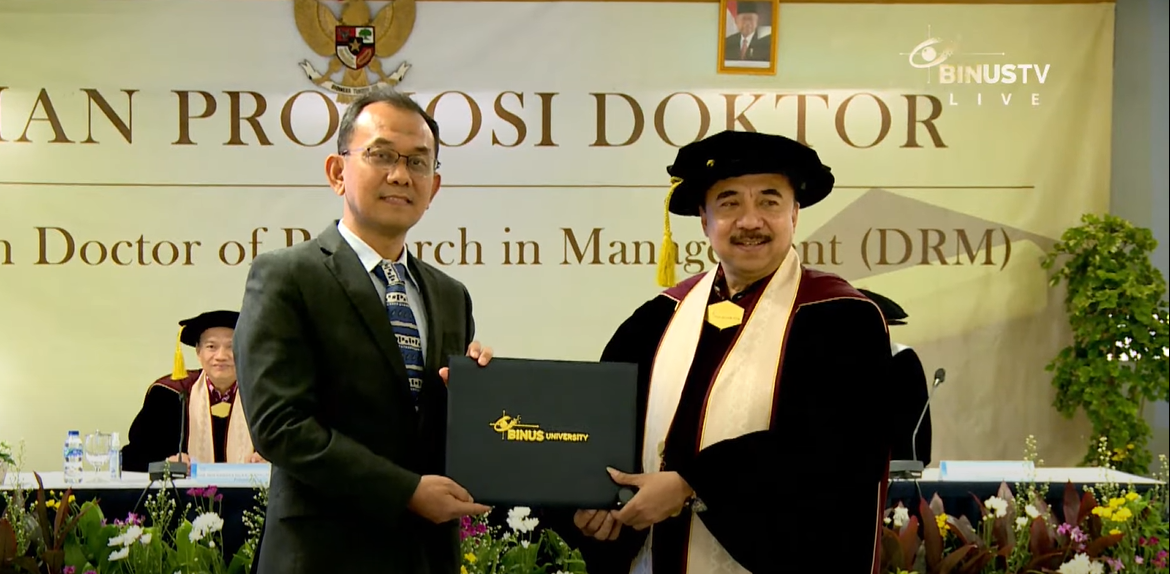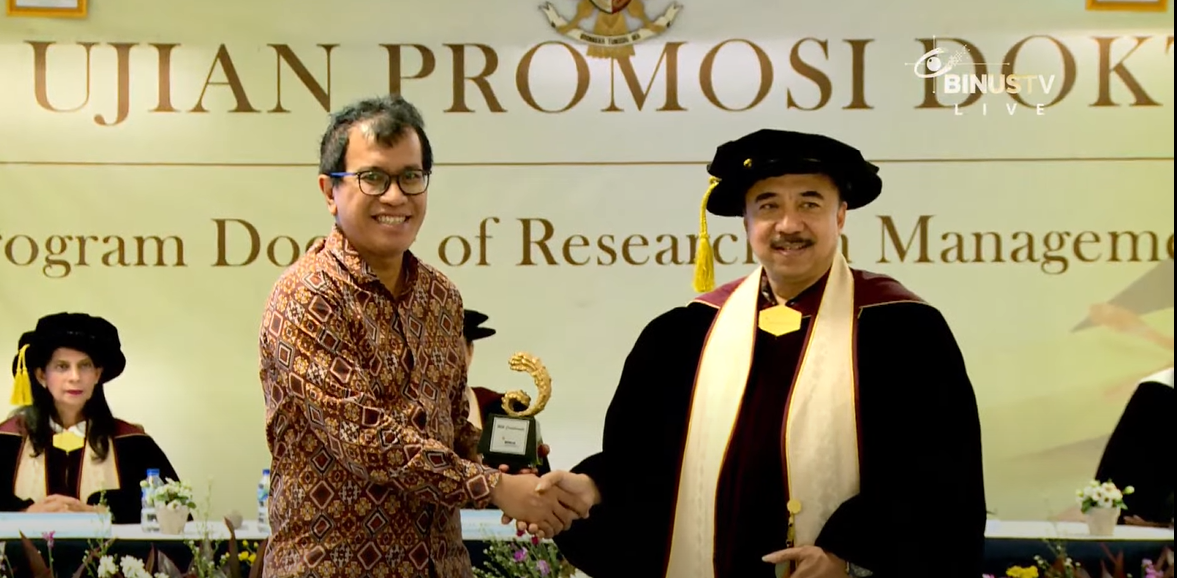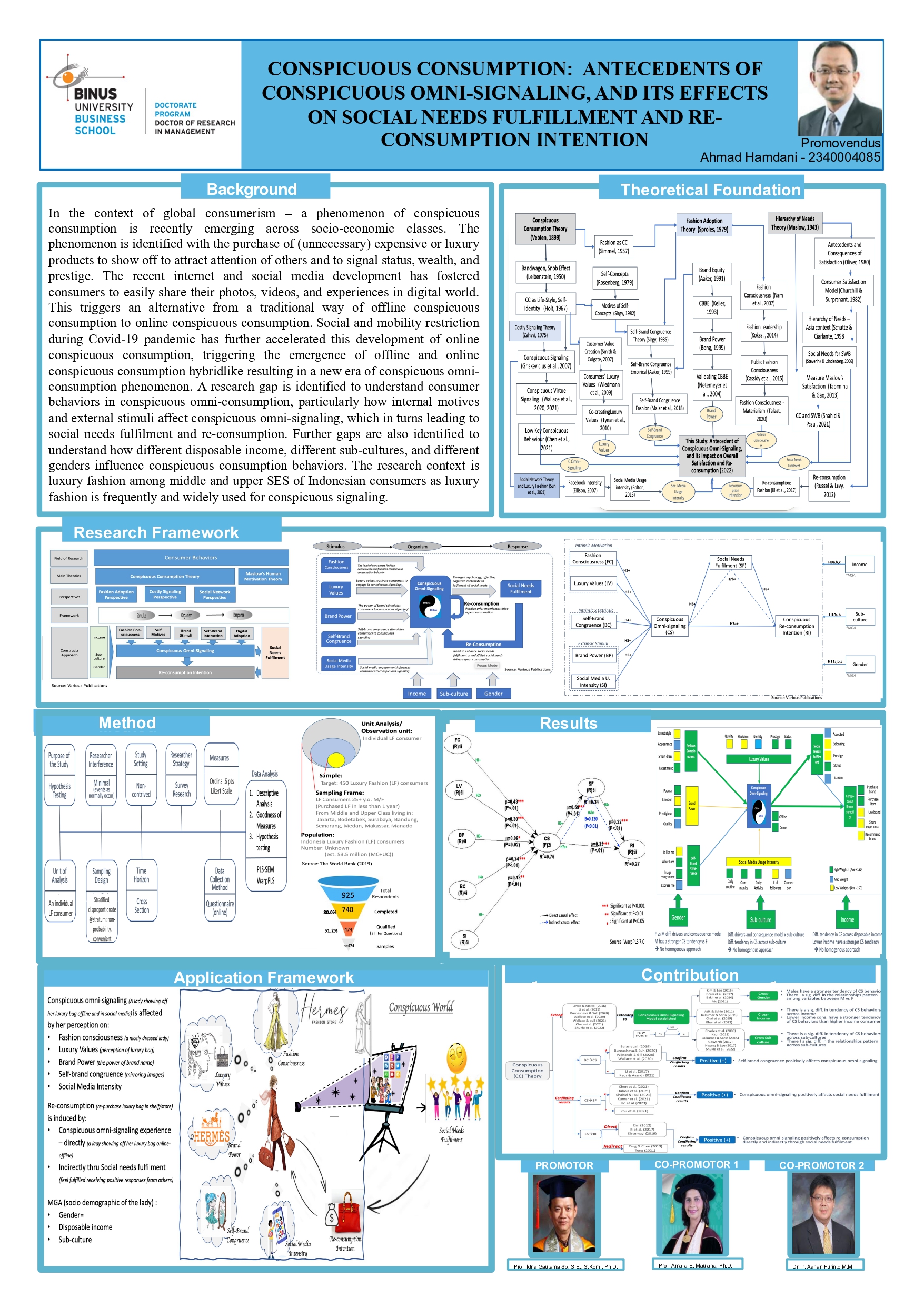Dissertation Examination of Ahmad Hamdani

On Monday, 15 January 2024, a Dissertation Examination for a DRM student, specializing on Strategy & Growth, on behalf of Ahmad Hamdani [2340004085] entitled “Conspicuous Consumption: Antecedents of Conspicuous Omni-Signaling, and Its Effects on Social Needs Fulfillment and Re-Consumption Intention” was held Alam Sutera, R. B0301, Bina Nusantara University.

The dissertation examination was led by Prof. Dr. Mts. Arief, MBA., CPM and attended by a team of promotors and examiners. There were three promotors in attendance with Prof. Idris Gautama So, S.E., S.Kom., M.M., Ph.D as a Promotor, Prof. Amalia E. Maulana, Ph.D as Co-Promotor 1, and Dr. Asnan Furinto, S.T., M.M. as Co-Promotor 2. There were also examiners present, with Prof. Dr. Ir. Mohammad Hamsal, MSE., MQM., M.B.A., CISCP, CPOD as Examiner 1, Dr. Rano Kartono, B.I.T., M.Buss (MIS)., CERA as Examiner 2, and Dr. Jastiro Abi as Examiner 3. Dr. Yahya Agung Kuntadi was also present as a guest speaker for the dissertation examination.

DISSERTATION SUMMARY
This study investigated consumer behaviors in conspicuous omni-signaling, including its internal motivation, external stimuli, and consequences on social needs fulfilment and re-consumption intention in the context of luxury fashion. Additionally, multigroup analysis was conducted across income, sub-cultures, and gender. Conspicuous signaling is identified with the display of conspicuous goods to signal status, wealth, prestige, and identity. Digital development has made conspicuous signaling radically emerged in social media by posting photos, videos, or stories of luxury goods. This drives an emerging phenomenon of conspicuous omni-signaling the use of both offline and online media to signal conspicuous consumption hybridlike.
As a new phenomenon, little is known in consumer behaviors related to conspicuous omni-signaling. An online survey was conducted to collect data from 474 valid respondents across eight cities representing various sub-cultures of Indonesian consumers. Veblen’s conspicuous consumption and Maslow’s human motivation theories were employed as the main lens for analysis. PLS-SEM technique was employed, as the research model uses mixed of reflective and formative constructs. WarpPLS 7.0 was used for data analysis.
The results indicated that fashion consciousness, luxury values, brand power, self-brand congruence, and social media usage intensity positively and significantly affect conspicuous omni-signaling. The effect of conspicuous omni-signaling on re-consumption is found significant both direct and indirect through social needs fulfilment. This study also found that the tendency of conspicuous omni-signaling behaviors extant across gender, income, and sub-cultures. Multigroup analysis found no significant difference in the relationships pattern among antecedents, conspicuous omni-signaling, and consequences between lower and higher income levels. However, a significant difference found in the relationships pattern across sub-cultures and gender.
This study extended the concept of conspicuous offline and online consumption to conspicuous omni-signaling, and extended the extant cross-subcultural, cross-gender, and cross-income of conspicuous consumption research. The results also extended Maslow’s human motivation theory by demonstrating fulfilment of social needs through conspicuous omni-signaling across sub-cultures, gender, and income. Moreover, the study also provided managerial contributions for luxury fashion practitioners and corporation.
BACKGROUND
Hamdani spent his early years attending school in Malang before moving to Blitar for his junior and high school education. He then went on to graduate with a degree in Informatics Engineering from the prestigious Bandung Institute of Technology (ITB) and earned an MBA from the Royal Melbourne Institute of Technology (RMIT) in Australia. His thirst for knowledge didn’t stop there—Hamdani attended executive leadership programs at world-renowned institutions like Kellogg School of Management (USA) and INSEAD (France), and furthered his studies at BINUS University, demonstrating his passion for lifelong learning.
His career has been an exciting journey. Hamdani started as an international field engineer with Schlumberger, an oil service company, and transitioned into the fast-paced world of FMCG, working with leading companies like P&G, Reckitt & Colman, Mead-Johnson, Danone, and Nestlé, in both Indonesia and overseas. Currently, he serves as the Managing Director of Knauf Plasterboard Indonesia and Knauf Gypsum Indonesia, showcasing his leadership in the industry.
Outside of his corporate life, Hamdani dedicates time to his personal passions, serving as the head of a tahfidz Qur’an boarding school, blending his professional achievements with a commitment to education and community development.
PUBLICATION
During his study in Doctor of Research in Management at BINUS University, Hamdani published articles in (Scopus indexed) journal and presented paper in international conferences:
- Ahmad Hamdani, Idris Gautama So, Amalia E. Maulana, Asnan Furinto, (2023), “How Can Conspicuous Omni-Signaling Fulfil Social Needs and Induce Re-consumption?”, Sustainability, Volume 15, Issue 11, 9015.
- Ahmad Hamdani, Amalia E. Maulana, Presenter at 9th International Conference on Business, Accounting, Finance, and Economics (BAFE) 13 Oct 2021, Universiti Tunkun Abdul Rahman, Malayia. Paper Title: Behavior Changes for Conspicuous Consumption in the New Normal Era”.
- Ahmad Hamdani, Idris Gautama So, Amalia E. Maulana, Asnan Furinto, 7th Binus Doctoral Progress Review (BDPR). BINUS University, 29 October 2022
Hamdani’s dissertation examination is available below.

